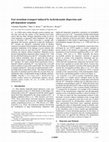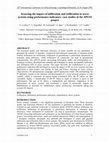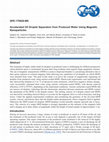Papers by Valentina Prigiobbe

International Petroleum Technology Conference, 2014
ABSTRACT Divalent cations, especially calcium (Ca 2ϩ), are known to significantly affect the perf... more ABSTRACT Divalent cations, especially calcium (Ca 2ϩ), are known to significantly affect the performance of anionic surfactants and polymers used in enhanced oil recovery (EOR) processes. An efficient technique to remove Ca 2ϩ from brine is reported, which is based on selective adsorption of Ca 2ϩ onto functionalized iron oxide magnetic nanoparticles (IOMNPs). Upon adsorption, the IOMNPs can be separated by applying a magnetic field, leaving behind softened water. IOMNP was synthesized by coprecipitation, and the amine-functionalization of its surface was obtained according to an aqueous APTES coating process. Chelating agent, polyacrylic acid (PAA), was successfully coated on amine-functionalized IOMNPs via amidation of carboxylic acid using 1-ethyl-3-(3-dimethylaminopropyl) carbodiimide (EDC). PAA modification significantly enhanced the adsorption capacity of IOMNPs due to their great ability to chelate Ca 2ϩ . The effect of pH on adsorption capacity was also investigated. The adsorption capacity of Ca 2ϩ onto PAA-IOMNPs was found to be as high as 57.2 mg/g at pH 7 from the 400 mg/L Ca 2ϩ solution. However, in American Petroleum Institute (API) standard brine (8ϫ10 4 mg/L NaCl and 2ϫ10 4 mg/L CaCl 2), the adsorption capacity of IOMNPs decreased to 9.8 mg/g since the high salinity screens the charges on the surface of PAA-IOMNPs and results in the formation of nanoparticle aggregates. PAA-IOMNPs can be reused after treated by acetic acid solution. A geochemical model was developed to describe the competitive adsorption of Ca 2ϩ and H ϩ onto amine-functionalized IOMNPs as a function of solution pH and Ca 2ϩ concentration. Comparison between the model and the experiments shows that the adsorption isotherms predict the behavior of the system very well. Below pH 4, adsorption of Ca 2ϩ is negligible and becomes important above pH 7. This opens the possibility of recovering the nanoparticles after the divalent cation removal, and reusing them for the repeated water softening.

As a fluid carries solutes through a porous material, species that sorb onto the surface of the m... more As a fluid carries solutes through a porous material, species that sorb onto the surface of the material travel more slowly than the fluid. Stronger adsorption results in slower solute migration, or increased solute retardation. The adsorption of strontium (Sr 2+) onto iron-oxides is strongly pH-dependent and becomes significant at high pH. Radioactive Sr 2+ isotopes are, therefore, commonly stored in alkaline solutions to maximize their retardation. Field observations and numerical simulations of the leakage of such solutions into low-pH soils, however, show that even Sr 2+ stored in alkaline solutions can migrate without retardation. Migration occurs because hydrodynamic dispersion allows mixing of Sr 2+ with the low-pH fluid forming an acidic Sr 2+-rich plume which can travel without retardation. Here we report the first experimental observations confirming this dispersion-induced fast Sr 2+ transport. We report column-flood experiments where a high-pH solution containing Sr 2+ was injected into a low-pH porous medium of iron-oxide-coated beads. We observe both a strongly retarded Sr 2+ front and an isolated fast pulse of Sr 2+ traveling at the average fluid velocity. This dispersion-induced fast pulse of strontium must be taken into account when considering the safety of radionuclide storage in alkaline solutions.

Water Practice and Technology, 2006
The structural quality and functional efficiency of sewer systems are key parameters to guarantee... more The structural quality and functional efficiency of sewer systems are key parameters to guarantee the transfer of domestic, commercial and industrial wastewater to treatment plants without infiltration nor exfiltration. Infiltration of groundwater is particularly detrimental to treatment plant efficiency, while exfiltration of wastewater can lead to groundwater contamination. The APUSS project associating universities, SMEs and municipalities in 7 European countries, developed new methods and techniques to assess and quantify infiltration and exfiltration (I/E) in sewer systems. This paper describes the establishment of a set of performance indicators (PI) developed to assess the impact of I/E on sewer systems and their application to three project case studies, in Italy and France, focusing on sewer systems characteristics, I/E measurements campaigns and PI application results. The methodology for PI definition consists in the selection and development of a sewer network property or state variable, which is expressive of aspects being scrutinized (I/E); the PI values are then calculated; finally, a classification of the PI values is made in relation to good or bad performance. The use of PI allows a standardized and objective comparison of the performance of sewer systems and constitutes a means to technically support the establishment of priorities for rehabilitation and/or construction investments taking into account I/E impacts.
Transport in Porous Media, 2015
The APUSS methods for assessing infiltration and exfiltration have been applied in two catchments i... more The APUSS methods for assessing infiltration and exfiltration have been applied in two catchments in Rome, namely Infernetto and Torraccia (Figure 1). The first catchment is essentially a residential area having a twenty years old separated sewer system with an ...

The structural state of sewer pipe is a crucial problem in urban areas because infiltrations and ... more The structural state of sewer pipe is a crucial problem in urban areas because infiltrations and exfiltrations can occur and consequently contaminate the surface and deep water bodies, respectively. In this paper the application of a new method to quantify the sewer leakages (called exfiltrations) with tracers during dry weather is discussed. This method, called QUEST-C (Quantification of Exfiltration from Sewers with the help of Tracers-Continuous Dosing) and developed by EAWAG (CH) within the European project APUSS, allows to estimate the exfiltrations by a mass balance of chemical tracers dosed continuously in a wastewater stream of operating sewers. In the paper, we sum up our experience from a number of field experiments in order to discuss the application of the method in the field, critically: (i) planning of the experiments; (ii) the reliability of the obtained results; (iii) the overall applicability of the method in an urban area. Finally, some findings with regard to the practical application and recommendations are presented for the future development of the method.
Nato Science Series: IV: Earth and Environmental Sciences, 2005
Preliminary results were presented for estimating exfiltration from an urban sewer system by a no... more Preliminary results were presented for estimating exfiltration from an urban sewer system by a novel method QUEST, which was developed by EAWAG in the European APUSS project. The application of this method to a structurally sound sewer in Rome proved that the method allows the assessment of exfiltration in an expedient and economic way. These results have provided reliable exfiltration

Water Science & Technology, 2011
Water authorities interested in the evaluation of the structural state of a sewer must quantify l... more Water authorities interested in the evaluation of the structural state of a sewer must quantify leakage to plan strategic intervention. However, the quantification of the exfiltration and the localisation of structural damage are challenging tasks that usually require expensive and time-consuming inspections. Herein, we report one of the first applications of the QUEST-C method to quantify the exfiltration in a continuously operating sewer by dosing two chemical tracers, sodium bromide (NaBr) and lithium chloride (LiCl). The method was applied at the catchment scale in a 14-year-old sewer in Rome, Italy. Preliminary laboratory tests, field measurements, and numerical simulations showed that reliable results require the QUEST-C method to be applied to sewers without lateral inflows, during periods of quasi-steady flow, and that the travel time of the NaBr tracer is minimised. Three sewer reaches were tested and the estimated exfiltration, as a fraction of the dry weather flow (DWF), increased from 0.128 in the agricultural area to 0.208 in the urban area. Although our estimates are at the lower end of the range given in the literature (0.01-0.56 DWF), the exfiltration was not negligible, and interventions should focus on the sewers in urban areas. This illustrates the capability of the QUEST-C method to guide strategic intervention at low cost and without an interruption of sewer operation. However, careful interpretation of the results is recommended for sewers with many lateral inflows, where leakage may be overestimated.

Water Science & Technology, 2009
The infiltration of parasitical water into two sewer systems in Rome (Italy) was quantified durin... more The infiltration of parasitical water into two sewer systems in Rome (Italy) was quantified during a dry weather period. Infiltration was estimated using the hydrograph separation method with two water components and delta(18)O as a conservative tracer. The two water components were groundwater, the possible source of parasitical water within the sewer, and drinking water discharged into the sewer system. This method was applied at an urban catchment scale in order to test the effective water-tightness of two different sewer networks. The sampling strategy was based on an uncertainty analysis and the errors have been propagated using Monte Carlo random sampling. Our field applications showed that the method can be applied easily and quickly, but the error in the estimated infiltration rate can be up to 20%. The estimated infiltration into the recent sewer in Torraccia is 14% and can be considered negligible given the precision of the method, while the old sewer in Infernetto has an estimated infiltration of 50%.
A direct approach to quantify exfiltration from sewers is the QUEST-C tracer method. In this stud... more A direct approach to quantify exfiltration from sewers is the QUEST-C tracer method. In this study, the authors present a novel approach for the dynamic analysis of a tracer experiment, considering information on varying sewer flow. An assessment of uncertainty is developed that accounts for systematic and random errors in the measurements and the sampling scheme. It is shown that the precision of the exfiltration measurement with tracers can be significantly improved by the dynamic analysis.
SPE Annual Technical Conference and Exhibition, 2014
Energy Procedia, 2009
The dissolution kinetics of olivine has been extensively studied under several temperatures, CO2 ... more The dissolution kinetics of olivine has been extensively studied under several temperatures, CO2 pressures, and solution compositions. Dissolution is an important mechanism in the aqueous mineral carbonation process. The overall carbonation reaction consists of dissolution of mineral silicate, e.g. olivine, serpentine and wollastonite, followed by carbonate precipitation, thus fixing CO2 into naturally occurring stable solids, such as magnesite and calcite.
Energy Procedia, Feb 1, 2009
... of different reaction routes for carbonation of APC residues Renato Baciocchi (a) *, Giulia C... more ... of different reaction routes for carbonation of APC residues Renato Baciocchi (a) *, Giulia Costa (a ... Italy b Department of Hydraulics, Transportation and Roads, University of Rome La Sapienza, Eudossiana 18 ... 50% of the total ash mass, consistent with the large Ca(OH)2 excess ...
Chemical Engineering Science, 2009
... Two different mechanisms for olivine dissolution have been postulated at , corresponding to a... more ... Two different mechanisms for olivine dissolution have been postulated at , corresponding to a pH-dependence for pH<8, and to no pH-dependence for higher values ( [Wogelius and Walther, 1991] , [Pokrovsky and Schott, 2000] and [Rosso and Rimstidt, 2000] ). ...
Siam Journal on Applied Mathematics, Sep 4, 2013
A theory for the solution of the Riemann problem for a one-dimensional, quasilinear, 2×2 system o... more A theory for the solution of the Riemann problem for a one-dimensional, quasilinear, 2×2 system of conservation laws describing reactive transport in a permeable medium with pH-dependent adsorption is developed. The system is strictly hyperbolic and nongenuinely nonlinear because the adsorption isotherms are not convex functions. The solution comprises nine fundamental structures, which are a concatenation of elementary and composed waves. In the limit of low pH, the isotherms reduce to convex two-component Langmuir isotherms considered in chromatography, and the solution comprises only four fundamental structures, as in classical theory. Semianalytical solutions and highly resolved numerical simulations show good agreement in all cases.

The treatment of highly stable small oil droplets in produced water is challenging for offshore p... more The treatment of highly stable small oil droplets in produced water is challenging for offshore production, where platform space is constrained, because their long residence time requires large equipment volumes. The use of magnetic nanoparticles (MNPs) to remove dispersed droplets is a promising alternative due to their quick response to external magnetic field, allowing easy separation of oil droplets on which MNPs were attached from water. The goal of this study is to prove the concept of magnetically separating oil droplets from produced water using surface-coated MNPs. Batch-scale experiments were performed and they showed that droplets in 5 wt. % of decane-in-water emulsions, which have negative surface charges, were successfully separated from water using cationic surfactant-coated MNPs, with decane removal efficiency of 85 to 99.99%, depending on the experiment conditions. Anionic surfactant-coated MNPs did not remove oil droplets, indicating that the electrostatic attractio...











Uploads
Papers by Valentina Prigiobbe